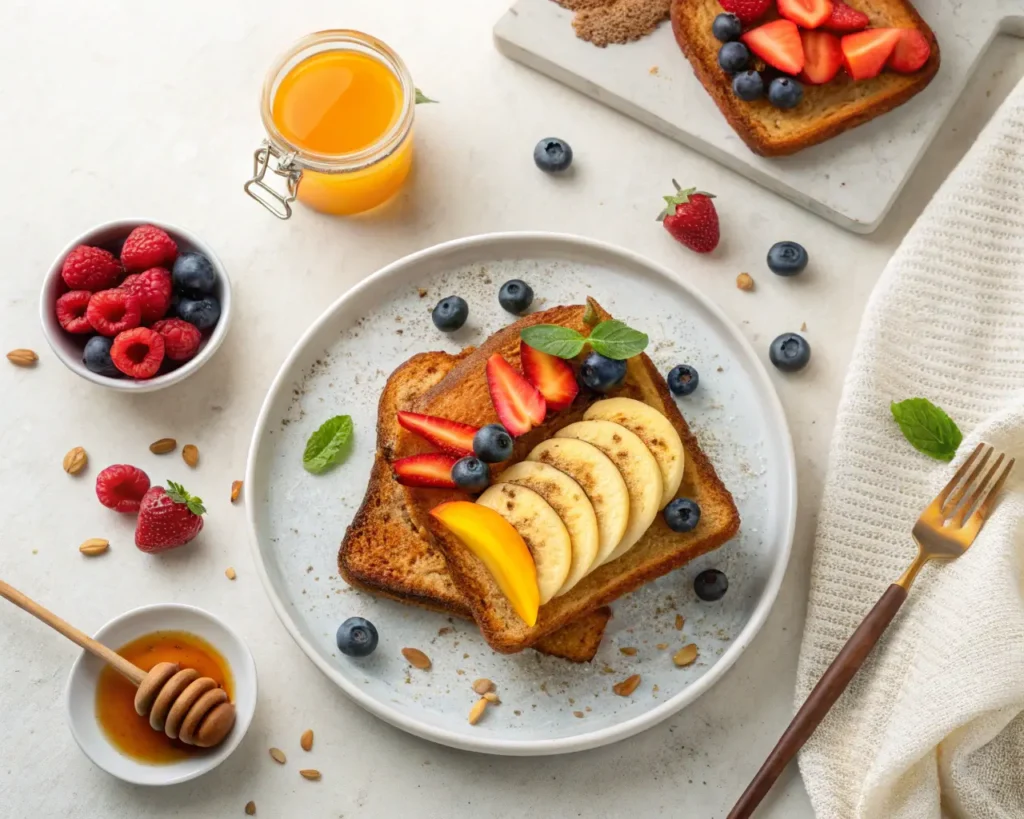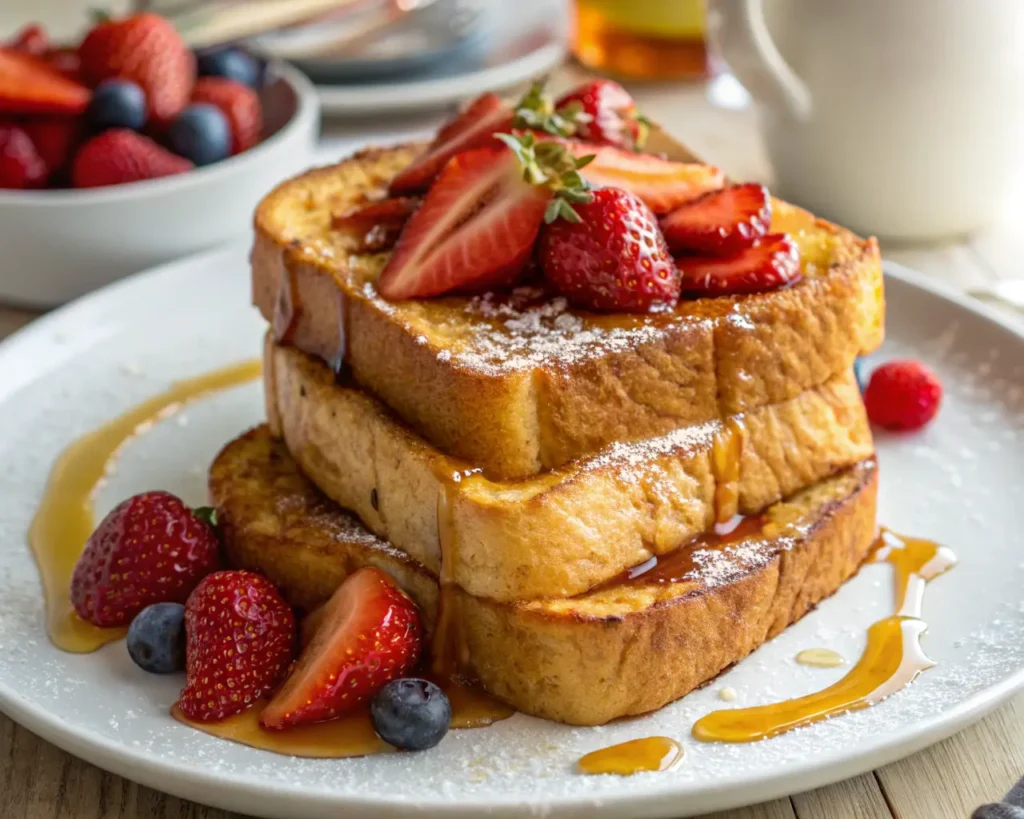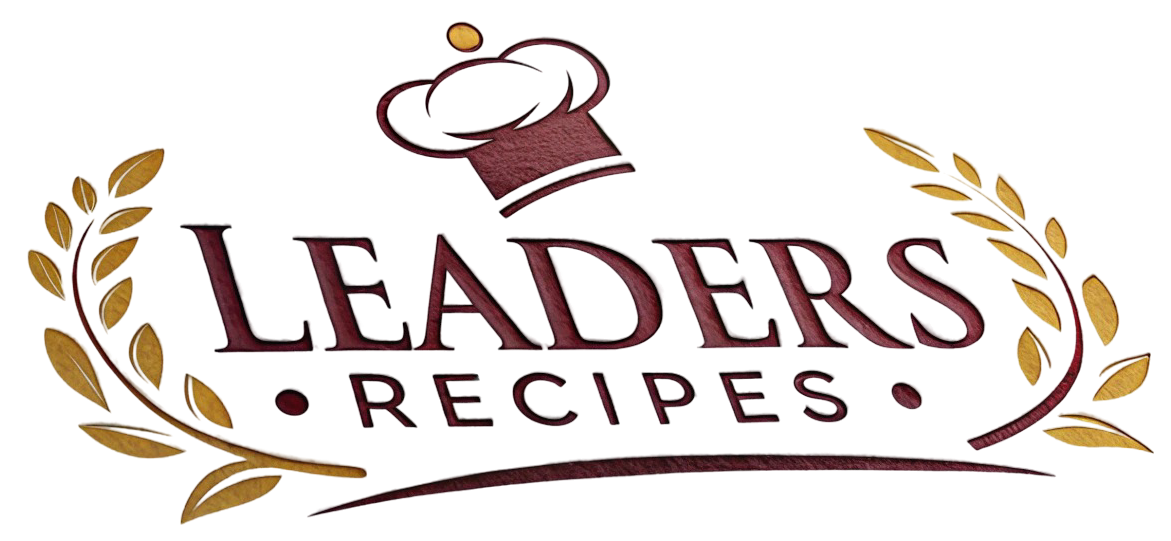Table of Contents
French toast, a beloved breakfast dish, has undergone a transformation from indulgence to health-consciousness. With just a few adjustments, you can turn this classic favorite into a nutrient-packed meal that not only satisfies your taste buds but also nourishes your body. This guide will delve into the elements that make healthy toast a great choice for a balanced and wholesome morning meal. Whether you’re looking to enjoy it on a busy weekday or serve it for a leisurely weekend brunch, this recipe is both easy and customizable to suit a range of dietary preferences and nutritional needs.
What Makes French Toast Healthy?
Ingredients that Enhance Nutrition
To elevate French toast into a healthy breakfast option, consider swapping out traditional ingredients for those that provide additional nutrients and fiber. Whole-grain bread is an excellent choice as it offers more fiber and essential vitamins than white bread. In place of regular milk or cream, you can use unsweetened almond milk or oat milk to lower the calorie count and reduce fat intake. Choosing natural sweeteners, such as honey or maple syrup, instead of refined sugar, ensures a more nutritious finish. These small changes can make a world of difference to your French-toast’s nutritional profile.
Low-Calorie Alternatives
One of the most significant advantages of making your own French-toast at home is the ability to control the ingredients. Rather than relying on heavy cream, opt for low-fat milk or plant-based alternatives. These substitutions lower the caloric content and saturated fat, without compromising on taste. Similarly, using egg whites or a combination of eggs and egg whites can help cut back on cholesterol while still offering the protein that helps fuel your morning.
Adding Fruits and Superfoods
To further enhance the health benefits of your toast, add fruits like berries, bananas, or even kiwi. These fruits not only provide a burst of flavor but also offer antioxidants, vitamins, and minerals that help keep your immune system strong and your skin glowing. Superfoods like chia seeds, flaxseeds, and hemp hearts can also be added to your batter for an extra dose of omega-3 fatty acids, fiber, and protein.


Ingredients for Healthy French Toast
Core Ingredients
The beauty of healthy French toast lies in its simplicity, requiring only a few basic ingredients. Start with whole-grain or sprouted bread, which provides a rich source of fiber and complex carbohydrates to keep you feeling full longer. Eggs, or egg whites for a lighter version, are a staple in French toast for their binding and protein qualities. For the liquid component, choose unsweetened almond milk or your preferred dairy or plant-based milk. Cinnamon and vanilla extract add warmth and natural sweetness, eliminating the need for added sugar.
Optional Add-Ins
To take your healthy toast to the next level, consider incorporating optional add-ins like nutmeg, orange zest, or unsweetened cocoa powder. These ingredients add subtle flavors that complement the cinnamon and vanilla without increasing the sugar content. Nutmeg, for instance, pairs beautifully with cinnamon, while cocoa powder adds richness without unnecessary calories.
Toppings for a Nutritious Boost
Once your toast is cooked, it’s time to think about toppings. Choose options that not only taste delicious but also boost your nutrient intake. Fresh fruits like blueberries, sliced strawberries, or raspberries are full of antioxidants. Greek yogurt provides a creamy, protein-packed topping, while a dollop of almond butter or peanut butter can contribute healthy fats and extra protein. For a touch of sweetness, drizzle your toast with pure maple syrup or a small amount of honey. These natural sweeteners can satisfy your sweet tooth without overpowering the dish.
Equipment Needed for Healthy French Toast
Essential Tools
To make healthy French toast, you’ll need a few kitchen tools. Start with a mixing bowl and a whisk to combine your batter. A non-stick skillet or griddle is essential to prevent the bread from sticking and to achieve a crispy exterior. A spatula will help you flip the French toast gently, ensuring even cooking. Finally, be sure to have measuring cups on hand to ensure accurate portions of each ingredient.
Optional Accessories
While the essential tools will suffice, you can also use an electric griddle if you’re preparing a larger batch. This will ensure the French toast cooks evenly and gives you the ability to make multiple pieces at once. For presentation, consider investing in serving plates to elevate the visual appeal of your dish.
Step-by-Step Instructions for Making Healthy French Toast
Step 1: Preparing the Batter
In a large mixing bowl, whisk together 2 eggs (or 4 egg whites), 1 cup of unsweetened almond milk, 1 tsp of cinnamon, and 1 tsp of vanilla extract. If you’re using any optional add-ins like nutmeg or orange zest, add them to the batter now. Whisk until everything is well combined, creating a smooth and slightly frothy mixture.
Step 2: Preparing the Bread
To ensure your French toast turns out perfectly crispy on the outside yet soft on the inside, use slightly stale bread. Fresh bread tends to absorb too much batter and becomes soggy. Whole-grain or sprouted bread is ideal as it provides additional fiber and nutrients. Cut the bread into slices, about 1 inch thick, and set aside.
Step 3: Cooking the French Toast
Heat a non-stick skillet or electric griddle over medium heat. Lightly coat the surface with a non-stick spray or a small amount of coconut oil. Dip each slice of bread into the prepared batter, ensuring it’s fully coated but not overly soaked. Place the bread on the skillet and cook for about 2-3 minutes on each side, or until golden brown and crispy. Be sure to keep the heat at medium to avoid burning the bread before it’s fully cooked.
Step 4: Plating and Topping
Once the French toast is cooked to perfection, transfer it to a plate and top with your favorite nutritious ingredients. Consider adding fresh berries, a dollop of Greek yogurt, or a drizzle of maple syrup for sweetness. You can also sprinkle some chia seeds or flaxseeds over the top to boost the omega-3 content. Serve immediately and enjoy!
Tips for Perfect Healthy French Toast
Choosing the Right Bread
The choice of bread is one of the most critical factors in making healthy French toast. Whole-grain bread is a top contender, as it is high in fiber and essential nutrients. If you’re gluten-sensitive, try using gluten-free bread options like rice flour bread or almond flour bread. Avoid using soft, fresh white bread, as it tends to become too soggy when dipped in batter.
Achieving the Perfect Texture
To get French toast with a crisp outer layer and a soft, custard-like interior, the key is to balance the amount of batter absorbed and the cooking time. Use stale bread for better absorption, and don’t allow the bread to sit too long in the batter. Cook each piece on medium heat to allow time for the bread to cook through without burning the exterior.
Keeping it Low-Calorie
You can make your healthy French toast even lower in calories by reducing the portion sizes and using toppings wisely. Instead of overloading on syrup or powdered sugar, try topping with fresh fruit and a light drizzle of maple syrup or honey. This keeps the dish flavorful but not overly indulgent.
Variations of Healthy French Toast
Protein-Packed French Toast
For a higher protein version of French toast, you can add protein powder to the batter or top your toast with Greek yogurt. This helps create a filling breakfast that will keep you energized throughout the day.
Vegan French Toast
If you follow a vegan diet, you can easily make French toast by replacing the eggs with flax eggs (1 tablespoon ground flaxseed mixed with 3 tablespoons water) and using plant-based milk like almond or soy milk.
Gluten-Free French Toast
For those with gluten sensitivity, opt for gluten-free bread and ensure all other ingredients are gluten-free. This version is just as tasty and will meet the needs of anyone avoiding gluten.
Banana French Toast
For a naturally sweet version, add mashed bananas to the batter. Not only do bananas provide sweetness, but they also add potassium and fiber to the dish.
Low-Calorie French Toast
By reducing the sugar content in the batter and using a sugar-free syrup, you can create a low-calorie French toast that’s perfect for those watching their caloric intake.
Topping Ideas for Healthy French Toast
Fresh Fruit and Berries
Top your French toast with strawberries, blueberries, or blackberries for a nutrient-dense boost. These fruits are rich in vitamins, antioxidants, and fiber.
Nut Butters and Yogurt
For added protein and healthy fats, consider topping with almond butter, peanut butter, or Greek yogurt. These options also make the dish more filling and provide a creamy texture.
Sweeteners and Garnishes
To finish off your French toast, use a light drizzle of maple syrup, a dusting of cinnamon, or even a sprinkle of powdered sugar. These add just the right amount of sweetness without overwhelming the dish.
Meal Prep and Storage Tips
Can You Make It Ahead of Time?
You can prep the batter ahead of time and store it in the fridge for up to 24 hours. If you prefer, you can also freeze cooked French toast for up to 3 months, making it an excellent choice for meal prep.
Storing Leftovers
Store any leftover cooked French toast in an airtight container in the fridge for up to 3 days. Reheat in the oven or skillet for the best results.
Reheating Instructions
To reheat, place the French toast in a preheated oven at 350°F (175°C) for about 5 minutes. Alternatively, you can reheat it on the skillet over medium heat for a few minutes to crisp it up again.
Health and Customization Options
Lowering Sugar Content
To reduce sugar intake, use fresh fruit and natural sweeteners like maple syrup or honey instead of refined sugars.
Adding Superfoods
Incorporate chia seeds, hemp hearts, or flaxseeds into the batter or as toppings to add more fiber, healthy fats, and protein to your dish.
Dairy-Free and Vegan-Friendly Options
For a completely dairy-free and vegan French toast, use plant-based milk, flax eggs, and vegan yogurt for a fully customized meal.
Common Mistakes to Avoid
Using the Wrong Bread
Avoid using fresh bread, as it tends to become too soggy when dipped in batter. Stale bread is perfect because it absorbs the batter without becoming overly mushy.
Overcooking or Undercooking
Make sure to cook the French toast on medium heat. Overcooking will burn the exterior, while undercooking leaves the inside soggy.
Skipping the Right Toppings
Toppings like fruit and Greek yogurt elevate the dish with extra nutrients and flavor. Don’t skip these essential components!
FAQs
Can I make French toast without eggs?
Yes, you can use flax eggs or chia eggs as a substitute for eggs in your French toast recipe.
How do I store and reheat French toast?
Store cooked French toast in an airtight container in the fridge for up to 3 days. Reheat in the oven or skillet for a crispy texture.
Can I freeze French toast for meal prep?
Yes, you can freeze French toast for up to 3 months. Just reheat it in the oven or skillet for a quick breakfast.
What’s the best bread for healthy French toast?
Whole-grain or sprouted bread is ideal for healthy French toast as it provides more fiber and nutrients than white bread.
How can I make French toast gluten-free?
Use gluten-free bread and check that all other ingredients are gluten-free for a safe and delicious meal.
Can I make a vegan version of French toast?
Yes, by using flax eggs or chia seeds and plant-based milk, you can make a completely vegan French toast.
Conclusion
Healthy French toast is not only a versatile and nutritious option for breakfast, but it’s also customizable to suit various dietary needs. From low-calorie versions to vegan and gluten-free alternatives, the possibilities are endless. With the right ingredients, tools, and toppings, you can create a delicious breakfast that fuels your body and keeps you satisfied all morning.

